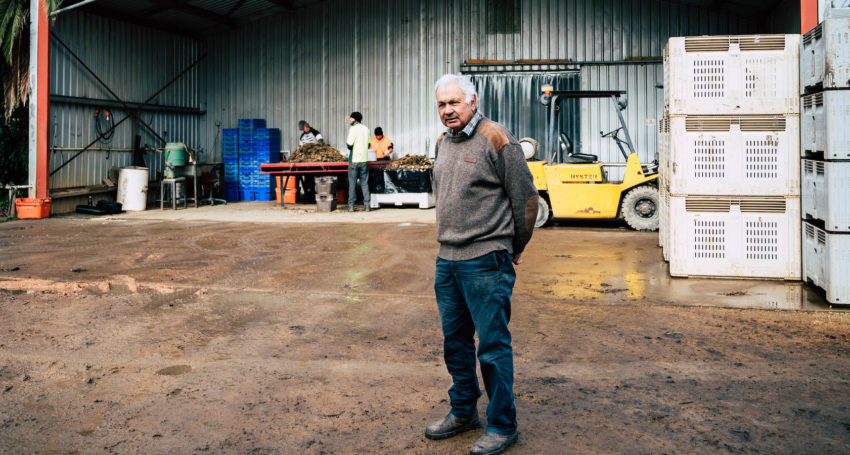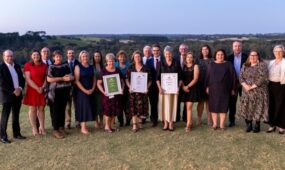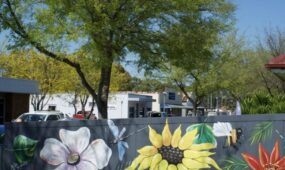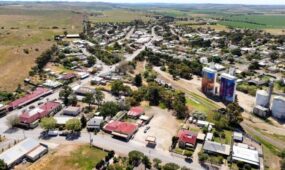Newman's Horseradish packs a spicy punch in Langhorne Creek
Regional
“Here, try some,” says Di at the famous Newman’s Horseradish farm in Langhorne Creek. She places a jar of the red-labelled horseradish paste and a barrel full of Jatz crackers before us.

Sign up to receive notifications about new stories in this category.
Thank you for subscribing to story notifications.

I dive in and load my biscuit up. So too does Brand South Australia’s photographer, Myles Quist. We’re exploring the home of Newman’s Horseradish farm in the Fleurieu Peninsula town of Langhorne Creek to learn all about this curious root vegetable.
Me, horseradish? Never tried it. Myles, I notice, is less generous and more delicate with his scoop. He’s only put a bit on his cracker. Wise, probably.
Horseradish farmer and processor Brian Meakins and team member Di keep talking, sharing all there is to know about the gnarled vegetable. I pop a biscuit heavily loaded with horseradish paste in my mouth. It tastes good. It is … spicy. Very spicy. And then the burn hits.
I stifle a cough as the horseradish paste unleashes its fiery wrath. Di notices and she chuckles. “It’s hot isn’t it! You’ll feel a second wave of heat soon.”
Horseradish, a thick white root vegetable, has a harsh bite and aroma when its flesh is grated or ground. Despite its pungent heat, Newman’s Horseradish paste – a gourmet condiment made from raw minced horseradish and mayonnaise – is a delicious sidekick to meat and fish, spread on sandwiches or used in salad dressings and dips.
There are very few commercial growers of this ancient root vegetable in Australia but Langhorne Creek has been home to horseradish for decades. The horseradish that end up in the iconic Newman’s jars are grown and processed on site by Brian and his wife Anne, and end up in household pantries and fridges across the country.
“Horseradish go back thousands of years,” says Brian. “We have lots of people, busloads, coming here all the time. They are fascinated by horseradish.”
Brian carried on the horseradish business from his father, who bought it from Fred Newman in Tea Tree Gully in 1947. The business moved to Langhorne Creek in 1985, eventually complementing a number of other agricultural interests in the town, namely wine grapes and horticultural crops such as Brussels sprouts and potatoes.
Langhorne Creek, an hour’s drive from Adelaide, is an underrated wine region and a hidden country town gem between the Adelaide Hills and Lake Alexandrina. About 5km from the town centre is the 25-acre horseradish farm, alongside the Meakins’ vineyards and Rusticana Wines cellar door.
With the horseradish harvest now in full swing, modified potato harvesters dig up the large roots which are then washed in a modified cement truck. The vegetables are further washed by hand before being weighed, chopped and ready for mincing. The business sells about 4000 jars of its products every week.
“We are mostly known for our original red label horseradish paste, and we do a horseradish and beetroot paste, horseradish mustard and horseradish dip, but the original red label is our biggest seller without a doubt,” Brian says.
“Our interstate market is building all the time, we are forever getting emails, ‘where can we find Newman’s on the Gold Coast or in Perth?’ We get requests from everywhere.”
Near the horseradish crops are grape vines planted in the early 1990s and playing a crucial part in a value-adding venture that helps bring people to the Meakins’ farm.
The Rusticana Wines cellar door is also on the property and takes its title from the botanical name for horseradish ‘Armoracia rusticana’. The cellar door stocks all the Newman’s Horseradish pastes and dips, including crushed ginger, crushed chilli-garlic paste, Dijon, hot English and seeded mustards, alongside products from other local food producers.
The Meakins grow two of the Langhorne Creek wine region’s top grape varieties – cabernet and shiraz, but also alternative varieties zinfandel, durif and tempranillo.
Rusticana produces about 2000 cases of wine a year and attracts hundreds of visitors to the cellar door every week.
Visitors can sit on the outdoor deck overlooking the horseradish crops, perhaps enjoying a glass of Rusticana’s cabernet sauvignon or the easy drinking tempranillo, with a (much lighter) spread of Newman’s Horseradish on deli meats and crackers.
Di says having the cellar door at the iconic Newman’s farm “just works”.
“Not everybody drinks wine and not everybody eats horseradish,” she says. “We’ll have a group of six people visit and they all go off and do their own thing.”
Photo by Myles Quist.
This story was first published by Brand South Australia for the Regional Showcase.
Jump to next article




